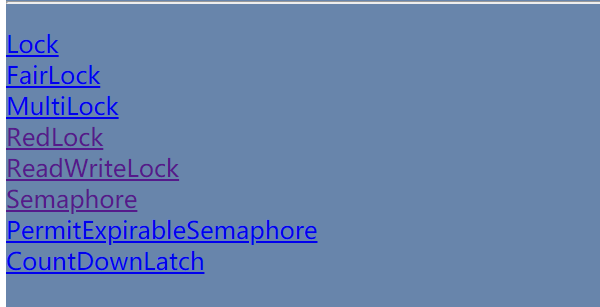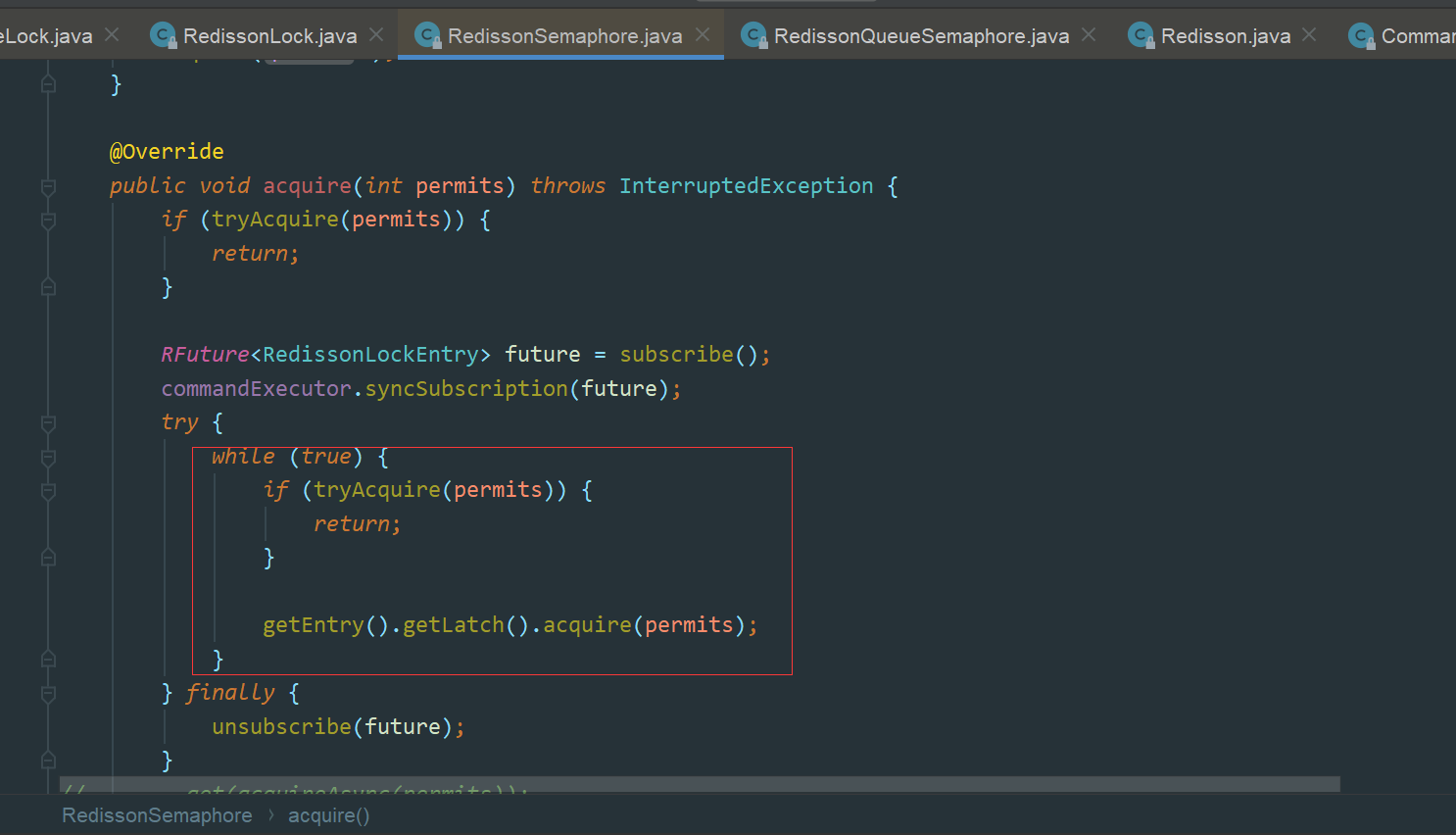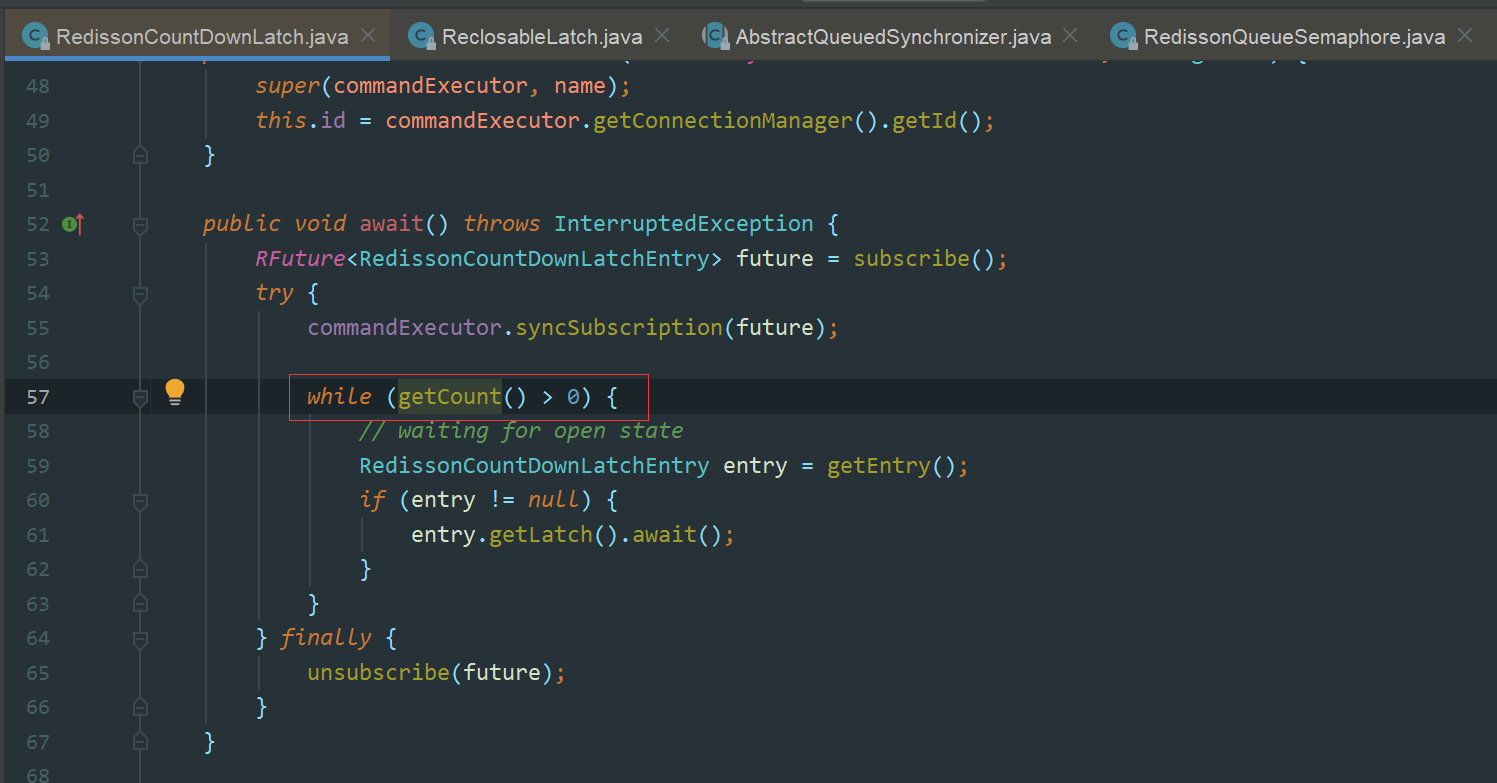前言
前面已经写了Redisson大多的内容,我们再看看Redisson官网共有哪些组件:
 image.png
image.png
剩下还有Semaphore和CountDownLatch两块,我们就趁热打铁,赶紧看看Redisson是如何实现的吧。
我们在JDK中都知道Semaphore和CountDownLatch两兄弟,这里就不多赘述,不了解的可以再回头看看。
Semaphore使用示例
先看下Semaphore原理图如下:
 image.png
image.png
接着我们看下Redisson中使用的案例:
RSemaphore semaphore = redisson.getSemaphore("semaphore");
// 同时最多允许3个线程获取锁
semaphore.trySetPermits(3);
for(int i = 0; i < 10; i++) {
new Thread(new Runnable() {
@Override
public void run() {
try {
System.out.println(new Date() + ":线程[" + Thread.currentThread().getName() + "]尝试获取Semaphore锁");
semaphore.acquire();
System.out.println(new Date() + ":线程[" + Thread.currentThread().getName() + "]成功获取到了Semaphore锁,开始工作");
Thread.sleep(3000);
semaphore.release();
System.out.println(new Date() + ":线程[" + Thread.currentThread().getName() + "]释放Semaphore锁");
} catch (Exception e) {
e.printStackTrace();
}
}
}).start();
}
Semaphore源码解析
接着我们根据上面的示例,看看源码是如何实现的:
第一步:
semaphore.trySetPermits(3);
public class RedissonSemaphore extends RedissonExpirable implements RSemaphore {
@Override
public boolean trySetPermits(int permits) {
return get(trySetPermitsAsync(permits));
}
@Override
public RFuture<Boolean> trySetPermitsAsync(int permits) {
return commandExecutor.evalWriteAsync(getName(), LongCodec.INSTANCE, RedisCommands.EVAL_BOOLEAN,
"local value = redis.call('get', KEYS[1]); " +
"if (value == false or value == 0) then "
+ "redis.call('set', KEYS[1], ARGV[1]); "
+ "redis.call('publish', KEYS[2], ARGV[1]); "
+ "return 1;"
+ "end;"
+ "return 0;",
Arrays.<Object>asList(getName(), getChannelName()), permits);
}
}
执行流程为:
- get semaphore,获取到一个当前的值
- 第一次数据为0, 然后使用set semaphore 3,将这个信号量同时能够允许获取锁的客户端的数量设置为3
- 然后发布一些消息,返回1
接着看看semaphore.acquire();和semaphore.release(); 逻辑:
public class RedissonSemaphore extends RedissonExpirable implements RSemaphore {
@Override
public RFuture<Boolean> tryAcquireAsync(int permits) {
if (permits < 0) {
throw new IllegalArgumentException("Permits amount can't be negative");
}
if (permits == 0) {
return RedissonPromise.newSucceededFuture(true);
}
return commandExecutor.evalWriteAsync(getName(), LongCodec.INSTANCE, RedisCommands.EVAL_BOOLEAN,
"local value = redis.call('get', KEYS[1]); " +
"if (value ~= false and tonumber(value) >= tonumber(ARGV[1])) then " +
"local val = redis.call('decrby', KEYS[1], ARGV[1]); " +
"return 1; " +
"end; " +
"return 0;",
Collections.<Object>singletonList(getName()), permits);
}
@Override
public RFuture<Void> releaseAsync(int permits) {
if (permits < 0) {
throw new IllegalArgumentException("Permits amount can't be negative");
}
if (permits == 0) {
return RedissonPromise.newSucceededFuture(null);
}
return commandExecutor.evalWriteAsync(getName(), StringCodec.INSTANCE, RedisCommands.EVAL_VOID,
"local value = redis.call('incrby', KEYS[1], ARGV[1]); " +
"redis.call('publish', KEYS[2], value); ",
Arrays.<Object>asList(getName(), getChannelName()), permits);
}
}
先看看加锁的逻辑tryAcquireAsync():
- get semaphore,获取到一个当前的值,比如说是3,3 > 1
- decrby semaphore 1,将信号量允许获取锁的客户端的数量递减1,变成2
- decrby semaphore 1
- decrby semaphore 1
- 执行3次加锁后,semaphore值为0
此时如果再来进行加锁则直接返回0,然后进入死循环去获取锁,如下图:
 image.png
image.png
接着看看解锁逻辑releaseAsync() :
- incrby semaphore 1,每次一个客户端释放掉这个锁的话,就会将信号量的值累加1,信号量的值就不是0了
看到这里大家就明白了了,Redisson实现Semaphore其实是很简单了
CountDownLatch使用示例
使用案例:
RCountDownLatch latch = redisson.getCountDownLatch("anyCountDownLatch");
latch.trySetCount(3);
System.out.println(new Date() + ":线程[" + Thread.currentThread().getName() + "]设置了必须有3个线程执行countDown,进入等待中。。。");
for(int i = 0; i < 3; i++) {
new Thread(new Runnable() {
@Override
public void run() {
try {
System.out.println(new Date() + ":线程[" + Thread.currentThread().getName() + "]在做一些操作,请耐心等待。。。。。。");
Thread.sleep(3000);
RCountDownLatch localLatch = redisson.getCountDownLatch("anyCountDownLatch");
localLatch.countDown();
System.out.println(new Date() + ":线程[" + Thread.currentThread().getName() + "]执行countDown操作");
} catch (Exception e) {
e.printStackTrace();
}
}
}).start();
}
latch.await();
System.out.println(new Date() + ":线程[" + Thread.currentThread().getName() + "]收到通知,有3个线程都执行了countDown操作,可以继续往下走");
CountDownLatch 源码解析
源码如下:
public class RedissonCountDownLatch extends RedissonObject implements RCountDownLatch {
@Override
public RFuture<Boolean> trySetCountAsync(long count) {
return commandExecutor.evalWriteAsync(getName(), LongCodec.INSTANCE, RedisCommands.EVAL_BOOLEAN,
"if redis.call('exists', KEYS[1]) == 0 then "
+ "redis.call('set', KEYS[1], ARGV[2]); "
+ "redis.call('publish', KEYS[2], ARGV[1]); "
+ "return 1 "
+ "else "
+ "return 0 "
+ "end",
Arrays.<Object>asList(getName(), getChannelName()), newCountMessage, count);
}
@Override
public RFuture<Void> countDownAsync() {
return commandExecutor.evalWriteAsync(getName(), LongCodec.INSTANCE, RedisCommands.EVAL_BOOLEAN,
"local v = redis.call('decr', KEYS[1]);" +
"if v <= 0 then redis.call('del', KEYS[1]) end;" +
"if v == 0 then redis.call('publish', KEYS[2], ARGV[1]) end;",
Arrays.<Object>asList(getName(), getChannelName()), zeroCountMessage);
}
}
先分析trySetCount()方法逻辑:
- exists anyCountDownLatch,第一次肯定是不存在的
- set redisson_countdownlatch__channel__anyCountDownLatch 3
- 返回1
接着分析latch.await();方法,如下图:
 image.png
image.png
这个方法其实就是陷入一个while true死循环,不断的get anyCountDownLatch的值,如果这个值还是大于0那么就继续死循环,否则的话呢,就退出这个死循环
最后分析localLatch.countDown();方法:
- decr anyCountDownLatch,就是每次一个客户端执行countDown操作,其实就是将这个cocuntDownLatch的值递减1
await()方面已经分析过,死循环去判断anyCountDownLatch对应存储的值是否为0,如果为0则接着执行自己的逻辑
总结
看到了这里 这两个组件是不是很简单?
到了这里,Redisson部分的学习都已经结束了,后面还会学习ZK实现分布式锁的原理。
申明
本文章首发自本人博客:https://www.cnblogs.com/wang-meng 和公众号:壹枝花算不算浪漫,如若转载请标明来源!
感兴趣的小伙伴可关注个人公众号:壹枝花算不算浪漫
